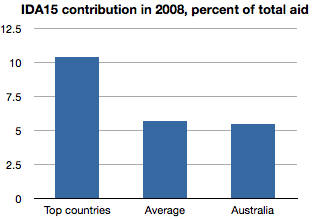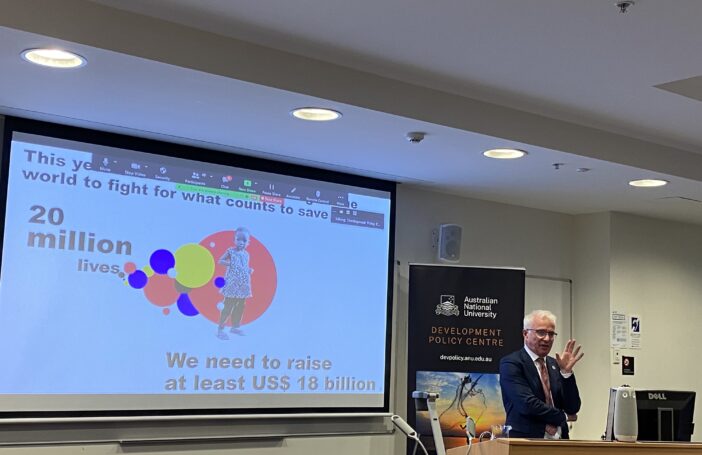A strong case can be made that Australia should be contributing much more to the International Development Association: perhaps as much as $1.7 billion over the next three years, compared to $0.6 billion over the last three. But this will require not just a bold decision, but a quick one, as the IDA replenishment deadline is December.
As Australia considers how to scale up aid to meet its 0.5 per cent of GNI target, the World Bank is on a fundraising drive for its concessional arm, the International Development Association, to increase support for low income countries.
Rich country governments have been meeting over the course of this year to discuss the sixteenth three-year replenishment of IDA (IDA16), They now have only until December to make a final decision on how much support they will give IDA over the period July 2011 to June 2014.
Australia was the twelfth largest donor in the last replenishment, contributing A$583 million over three years or about 5 percent of total Australian aid. The most generous countries contribute about 10 percent of their aid budgets to IDA, but Australia’s contribution is about the average.
If Australia were to continue to allocate 5 per cent of its aid to IDA, then it would contribute about $850 million to IDA16 over the next three years. If Australia matched the top five donors, and gave 10 percent of its aid to IDA, then it would contribute about $1.7 billion. Australia could, conceivably, also go further and matching the most generous country from the last round, the UK on 12 percent, and contribute $2 billion.
There is a good case for generous support to IDA:
- Delivery through an effective donor. IDA performed well in a recent assessment of the quality of aid by CDG and Brookings, and has a track record of delivering results. The IDA replenishment is an opportunity for Australia to help scale up this success, while easing pressures on its own increasingly stretched bilateral program.
- More aid to Africa and other poor countries. One of the main thrusts of the scaling-up of Australian aid in the last few years has been to give more aid to Africa. But Africa is a continent already over-burdened with donors, and expanding to Africa will over-stretch AusAID’s capacity. It makes sense to give more to Africa, but only if we do so through others. If Australia were to give $2 billion to IDA in the next round, about one-half of this would go to Sub-Saharan Africa. Another 18 per cent would go to South Asia – again a poor region where Australia doesn’t have a strong presence or comparative advantage, but plans to increase aid. In general, more aid to IDA would also contribute to Australia’s recently-announced target of 0.15 per cent of GNI for least development countries, a target which otherwise would be very difficult to meet.
- More multilateral aid. Out of all the bilateral donors, Australia is the one which provides the smallest amount of core funding to the multilateral donors (as a percentage of total aid). This might have made sense when our focus was on the Pacific, where the multilateral agencies are not very active, but not now, as the aid program expands its footprint. The Government has said it wants to work more with the multilateral system. IDA, the biggest and in many ways the leading multilateral aid agency worldwide, should be at the centre of any strategy of enhanced engagement.
- Increased influence. A big increase in contributions would enable Australia to ‘punch above its weight’ in the important debates underway about the future of the World Bank. Australia would be able to push with greater strength for important reforms it is already advocating, such as a greater say for developing countries in the running of the World Bank, and a merit-based, competitive selection process for the next World Bank President.
If Australia is going to successfully double its aid program by 2015 to $8 billion from the current $4 billion, it will have to do things differently. Bold decisions will be needed, and quickly. A good place to start would be doubling our IDA support from five to 10 per cent.
Matthew Morris is a Research Fellow at the Crawford School and the Deputy Director of the Development Policy Centre.
Note: The calculation of IDA15 contribution to aid is based on one third of each country’s IDA15 pledge divided by their total ODA in 2008. The data is from IDA and OECD DAC.






Hi Matt,
Its great to have these debates on the table. Perhaps we can play the devil’s advocate on this one.
1. Certainly multilaterals offer the capacity to channel large amounts of the Australian aid dollar – that is a benefit in a scaled up world.
2. Multilaterals are often favoured on basis that they reduce efficiency on recipient countries and thus more ore in line with principles of aid effectiveness, however, multilaterals no longer enjoy a major advantage in having low transaction costs. Their compliance procedures have become more cumbersome and costly. Is there evidence to support the claim of lower transaction costs? The jury may be out on that one.
3. Effectiveness of multilateral activities is difficult to establish (and contributions therein even moreso). Will this cause a problem for Australia’s greater accountability focus?
4. The ability of multilaterals to mobilise sufficient funds for large-scale ‘development’ projects is often cited as one of their key advantages however in many countries where the technical expertise necessary to manage large-scale programs is absent, some of the aid money is channelled to companies, consultants and technical experts that oversee the projects anyway. Will this be a problem with the strong committment from Australia to reduce TA? Will Australia be able to understand and account for the proprotion of multilateral funds that are channeled to TA?
5. A long-standing issue surrounding aid from multilaterals is conditionality – does Australia have the opportunity to consider and form views on conditionalities in multilateral programs its funds?
The issue of multilaterals will be considered in the current aid review – we will watch with interest their commentary on the issue. But as Peter McCawley aptly noted – it all depends on your objectives!
Hi Matt,
Congratulations, on what I think is a great paper. Making a case for more aid through multilateral in the current economic climate and climate of ever increasing scrutiny is a big challenge and you measure up to the challenge really well. IDA 15 has had great achievements and more financial resources for scaling up the good work through IDA 16 makes sense. But that should not undermine the importance of reform of the BW institutions, in particular need for decentralisation, especially to African regions, and the need to reduce WB’s own transactions cost – e.g. it is interesting that WB continues with its fly-business policy when Ministers from some of its main donors are flying economy to get more value for their tax payers’ hard-earned money!